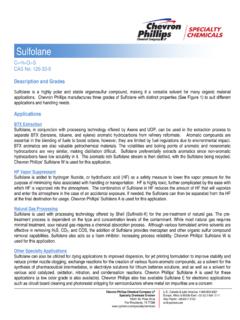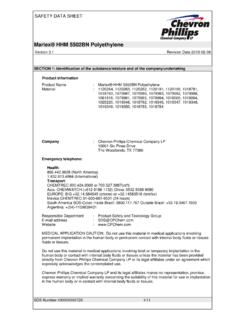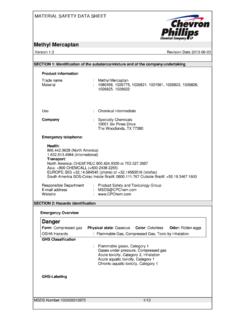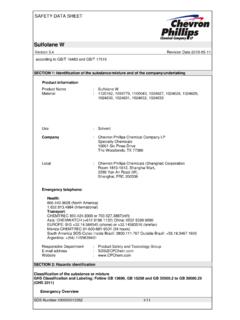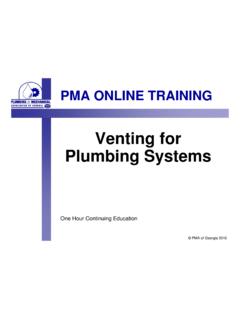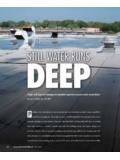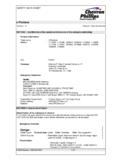Transcription of Jet A Aviation Fuel - Chevron Phillips Chemical
1 SAFETY DATA SHEET Jet A Aviation Fuel Version Revision Date 2016-05-17 SDS Number:100000014588 1/15 SECTION 1: Identification of the substance/mixture and of the company/undertaking Product information Product Name : Jet A Aviation Fuel Material : 1102484, 1103429, 1102481, 1103418, 1102485, 1102483, 1102482, 1024254, 1024255, 1024256, 1024257, 1104981, 1104992 Use : Fuel Company : Chevron Phillips Chemical Company LP Specialty Chemicals 10001 Six Pines Drive The Woodlands, TX 77380 Emergency telephone: Health: (North America) (International) Transport: CHEMTREC or (int'l) Asia: +800 CHEMCALL (+800 2436 2255) China:+86-21-22157316 EUROPE: BIG + (phone) or + (telefax) South America SOS-Cotec Inside Brazil: Outside Brazil: + Responsible Department : Product Safety and Toxicology Group E-mail address : Website : SECTION 2: Hazards identification Classification of the substance or mixture This product has been classified in accordance with the hazard communication standard 29 CFR ; the SDS and labels contain all the information as required by the standard.
2 Emergency Overview Danger Form: Liquid Physical state: Liquid Color: Clear light yellow OSHA Hazards : Flammable Liquid, Carcinogen, Mild skin irritant, Aspiration hazard, Delayed target organ effects SAFETY DATA SHEET Jet A Aviation Fuel Version Revision Date 2016-05-17 SDS Number:100000014588 2/15 Classification : Flammable liquids , Category 3 Skin irritation , Category 2 Carcinogenicity , Category 2 Specific target organ systemic toxicity - single exposure , Category 3 , Central nervous system Specific target organ systemic toxicity - repeated exposure , Category 1 , Eyes, Blood Aspiration hazard , Category 1 Labeling Symbol(s) : Signal Word : Danger Hazard Statements : H226: Flammable liquid and vapor. H304: May be fatal if swallowed and enters airways. H315: Causes skin irritation. H336: May cause drowsiness or dizziness.
3 H351: Suspected of causing cancer. H372: Causes damage to organs (Eyes, Blood) through prolonged or repeated exposure. Precautionary Statements : Prevention: P201 Obtain special instructions before use. P202 Do not handle until all safety precautions have been read and understood. P210 Keep away from heat/sparks/open flames/hot surfaces. No smoking. P233 Keep container tightly closed. P240 Ground/bond container and receiving equipment. P241 Use explosion-proof electrical/ ventilating/ lighting/ equipment. P242 Use only non-sparking tools. P243 Take precautionary measures against static discharge. P260 Do not breathe dust/fume/gas/mist/vapor/spray. P264 Wash skin thoroughly after handling. P270 Do not eat, drink or smoke when using this product. P271 Use only outdoors or in a well-ventilated area. P280 Wear protective gloves/ protective clothing/ eye protection/ face protection.
4 Response: P301 + P310 IF SWALLOWED: Immediately call a POISON CENTER/doctor. P303 + P361 + P353 IF ON SKIN (or hair): Take off immediately all contaminated clothing. Rinse skin with water/shower. P304 + P340 + P312 IF INHALED: Remove person to fresh air and keep comfortable for breathing. Call a POISON CENTER/doctor if you feel unwell. P308 + P313 IF exposed or concerned: Get medical advice/ attention. P331 Do NOT induce vomiting. P332 + P313 If skin irritation occurs: Get medical advice/ SAFETY DATA SHEET Jet A Aviation Fuel Version Revision Date 2016-05-17 SDS Number:100000014588 3/15 attention. P362 Take off contaminated clothing and wash before reuse. P370 + P378 In case of fire: Use dry sand, dry Chemical or alcohol-resistant foam to extinguish. Storage: P403 + P233 Store in a well-ventilated place. Keep container tightly closed. P403 + P235 Store in a well-ventilated place.
5 Keep cool. P405 Store locked up. Disposal: P501 Dispose of contents/ container to an approved waste disposal plant. Carcinogenicity: IARC Group 2B: Possibly carcinogenic to humans Naphthalene 91-20-3 NTP Reasonably anticipated to be a human carcinogen Naphthalene 91-20-3 ACGIH Confirmed animal carcinogen with unknown relevance to humans Kerosene C9-C16 8008-20-6 SECTION 3: Composition/information on ingredients Synonyms : Aviation Turbine Fuel A Kerosene Turbine Fuel Kerosene Jet A-1 Fuel Jet A Fuel Molecular formula : UVCB Component CAS-No. Weight % Kerosene C9-C16 8008-20-6 100 Naphthalene 91-20-3 0 - 3 SECTION 4: First aid measures General advice : Move out of dangerous area. Show this material safety data sheet to the doctor in attendance. Material may produce a serious, potentially fatal pneumonia if swallowed or vomited.
6 If inhaled : Consult a physician after significant exposure. If unconscious place in recovery position and seek medical advice. In case of skin contact : If skin irritation persists, call a physician. If on skin, rinse well with water. If on clothes, remove clothes. In case of eye contact : Flush eyes with water as a precaution. Remove contact lenses. Protect unharmed eye. Keep eye wide open while rinsing. If eye irritation persists, consult a specialist. SAFETY DATA SHEET Jet A Aviation Fuel Version Revision Date 2016-05-17 SDS Number:100000014588 4/15 If swallowed : Keep respiratory tract clear. Never give anything by mouth to an unconscious person. If symptoms persist, call a physician. Take victim immediately to hospital. Keep respiratory tract clear. Do NOT induce vomiting. Do not give milk or alcoholic beverages.
7 Never give anything by mouth to an unconscious person. If symptoms persist, call a physician. Take victim immediately to hospital. SECTION 5: Firefighting measures Flash point : C ( F) Autoignition temperature : 210 C (410 F) Suitable extinguishing media : Alcohol-resistant foam. Carbon dioxide (CO2). Dry Chemical . Unsuitable extinguishing media : High volume water jet. Specific hazards during fire fighting : Do not allow run-off from fire fighting to enter drains or water courses. Special protective equipment for fire-fighters : Wear self-contained breathing apparatus for firefighting if necessary. Further information : Collect contaminated fire extinguishing water separately. This must not be discharged into drains. Fire residues and contaminated fire extinguishing water must be disposed of in accordance with local regulations.
8 For safety reasons in case of fire, cans should be stored separately in closed containments. Use a water spray to cool fully closed containers. Fire and explosion protection : Do not spray on an open flame or any other incandescent material. Take necessary action to avoid static electricity discharge (which might cause ignition of organic vapors). Keep away from open flames, hot surfaces and sources of ignition. Hazardous decomposition products : Hydrocarbons. Carbon oxides. SECTION 6: Accidental release measures Personal precautions : Use personal protective equipment. Ensure adequate ventilation. Remove all sources of ignition. Evacuate personnel to safe areas. Beware of vapors accumulating to form explosive concentrations. Vapors can accumulate in low areas. Environmental precautions : Prevent product from entering drains.
9 Prevent further leakage or spillage if safe to do so. If the product contaminates rivers and lakes or drains inform respective authorities. SAFETY DATA SHEET Jet A Aviation Fuel Version Revision Date 2016-05-17 SDS Number:100000014588 5/15 Methods for cleaning up : Contain spillage, and then collect with non-combustible absorbent material, ( sand, earth, diatomaceous earth, vermiculite) and place in container for disposal according to local / national regulations (see section 13). SECTION 7: Handling and storage Handling Advice on safe handling : Avoid formation of aerosol. Do not breathe vapors/dust. Avoid exposure - obtain special instructions before use. Avoid contact with skin and eyes. For personal protection see section 8. Smoking, eating and drinking should be prohibited in the application area. Take precautionary measures against static discharges.
10 Provide sufficient air exchange and/or exhaust in work rooms. Open drum carefully as content may be under pressure. Dispose of rinse water in accordance with local and national regulations. Advice on protection against fire and explosion : Do not spray on an open flame or any other incandescent material. Take necessary action to avoid static electricity discharge (which might cause ignition of organic vapors). Keep away from open flames, hot surfaces and sources of ignition. Storage Requirements for storage areas and containers : No smoking. Keep container tightly closed in a dry and well-ventilated place. Containers which are opened must be carefully resealed and kept upright to prevent leakage. Observe label precautions. Electrical installations / working materials must comply with the technological safety standards. SECTION 8: Exposure controls/personal protection Ingredients with workplace control parameters US Ingredients Basis Value Control parameters Note Kerosene C9-C16 ACGIH TWA 200 mg/m3 CNS impair, URT irr, skin irr, P, A3, Skin, varies, OSHA Z-1 TWA 500 ppm, 2,000 mg/m3 (b), OSHA Z-1-A TWA 400 ppm, 1,600 mg/m3 Naphthalene ACGIH TWA 10 ppm, hematologic eff, URT irr, eye irr, eye dam, (), A4, Skin, ACGIH STEL 15 ppm, hematologic eff, URT irr, eye irr, eye dam, (), A4, Skin, OSHA Z-1 TWA 10 ppm, 50 mg/m3 (b), OSHA Z-1-A TWA 10 ppm, 50 mg/m3 OSHA Z-1-A STEL 15 ppm, 75 mg/m3 () Adopted values or notations enclosed are those for which changes are proposed in the NIC (b) The value in mg/m3 is approximate.

